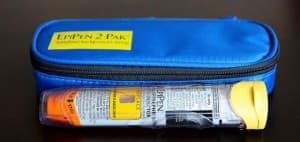 We’ve talked about epinephrine auto-injectors before on Food Allergy Living, including how to travel with them and what to do in case of an accidental injection of epinephrine. With the new school year upon us, many parents of children with food allergies are faced with the dilemma of where to store their child’s epinephrine auto-injector at school. Should they carry it with them at all times? Should it be stored in the nurse’s office? What happens on the playground or on a field trip?
We’ve talked about epinephrine auto-injectors before on Food Allergy Living, including how to travel with them and what to do in case of an accidental injection of epinephrine. With the new school year upon us, many parents of children with food allergies are faced with the dilemma of where to store their child’s epinephrine auto-injector at school. Should they carry it with them at all times? Should it be stored in the nurse’s office? What happens on the playground or on a field trip?
Carrying Epinephrine at School
If your child is old enough, some schools will allow them to carry the epinephrine auto-injector with them at school or on a field trip and self-administer in the case of a reaction. To find out specific details about what the legislation mandates in your state, you can visit the Allergy & Asthma Network website which provides overview for each state’s current law regarding anaphylaxis medications. View School Stock Epinephrine Laws.
If you are wondering how many epinephrine pens your child should carry at school, we have a separate blog post on this topic. Read How Many Epinephrine Auto-injectors Should Your Child Have On Hand?
Epinephrine in the Classroom as well as the Nurse’s Office
If your child is not old enough to carry their own epinephrine auto-injector, or their school will not allow it, you will want to determine whether or not one can be stored in their classroom (in addition to the nurse’s office). If they are in multiple classrooms each day, you may want to store one auto-injector in each room to be safe. You will also want to make sure that all of your children’s teachers are properly trained in how to administer the epinephrine.
Planning for Epinephrine Use When Outside the Classroom
One thing that can help you address where your child’s epineprhine or other medications are stored at school is a 504 plan. A 504 plan refers to Section 504 of the Americans with Disabilities Act, which ensures that children with special needs get a level playing field from government services like public school. Depending on the details of your child’s food allergy, he or she may qualify for a 504 plan for the school to follow. The plan will outline not only where their epinephrine auto-injector is stored, but also where they will eat, what allergens are permitted on school grounds, and how teachers and other personnel are trained to react in the event of an anaphylactic reaction.
Planning ahead is key to ensuring that your child will be safe at school in the event of an allergic reaction. What plans do you have in place for your children?
–






